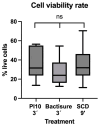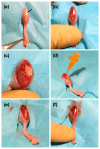Does a Specific Sequential Combination of Antiseptic Solutions for Chemical Debridement in Periprosthetic Joint Infection Improve Outcomes vs. Solution Alone? An In Vivo Study
- PMID: 39766614
- PMCID: PMC11727590
- DOI: 10.3390/antibiotics13121225
Does a Specific Sequential Combination of Antiseptic Solutions for Chemical Debridement in Periprosthetic Joint Infection Improve Outcomes vs. Solution Alone? An In Vivo Study
Abstract
Background: Chemical debridement is a fundamental step during the surgical treatment of both acute and chronic periprosthetic joint infection (PJI). However, there is no consensus on the optimal solution, nor is there sufficient evidence on the optimal irrigation time and combination of solutions. In an in vitro study, our group recently demonstrated that sequential combination debridement (SCD) with 3% acetic acid (AA) followed by 10% povidone iodine (PI) and 5 mM hydrogen peroxide (H2O2) was the best strategy for reducing bacterial load. The present study aimed to validate these findings in an in vivo model. Results: The median (IQR) log CFU/mL was lower in the group of mice treated with SCD (2.85 [0.00-3.72]) than in the Bactisure™ group (4.02 [3.41-4.72], p = 0.02). While this reduction was also greater than in the PI group (3.99 [1.11-4.33]), the difference did not reach statistical significance (p = 0.19). Cell viability assays showed no differences between treatments. S. aureus bacteremia was detected in 10% of mice treated with SCD, compared to 30% in the PI group and 10% in the Bactisure™ group. The difference was not statistically significant (p = 0.36). Conclusion: Our findings confirm that SCD significantly reduced bacterial load in an in vivo S. aureus PJI model, showing superior anti-biofilm activity compared to Bactisure™ and comparable performance to PI alone. These results highlight SCD's potential to serve as a standardized chemical debridement protocol, combining enhanced efficacy with clinical applicability. Methods: We tested SCD with 3% AA for 3 min, 10% PI for 3 min, and H2O2 for 3 min in a 7-day Staphylococcus aureus (ATCC29213)-based murine femur PJI model and compared the results with single treatments of 10% PI for 3 min or Bactisure™ solution for 3 min. A sterile steel implant with local administration of saline solution for 3 min was used as a non-infected control. After completing irrigation procedures, under anesthesia, mice were euthanized, and implants were analyzed for CFU/mL counts and cell viability rates. Blood cultures were obtained pre-euthanasia to detect bacteremia.
Keywords: biofilm; chemical debridement; murine model; reduction; sequential combination.
Conflict of interest statement
The authors declare no conflicts of interest.
Figures






Similar articles
-
An In Vitro Study to Assess the Best Strategy for the Chemical Debridement of Periprosthetic Joint Infection.Antibiotics (Basel). 2023 Oct 2;12(10):1507. doi: 10.3390/antibiotics12101507. Antibiotics (Basel). 2023. PMID: 37887208 Free PMC article.
-
Efficacy of the preformulated irrigation solution Bactisure® in acute periprosthetic joint infection debridement surgery: study protocol for a randomized controlled trial.Trials. 2024 Nov 16;25(1):775. doi: 10.1186/s13063-024-08637-1. Trials. 2024. PMID: 39550574 Free PMC article.
-
Efficacy of Different Irrigation Solutions on Bacterial Biofilm in Periprosthetic Joint Infections: A Systematic Review and Network Meta-Analysis.Life (Basel). 2025 Apr 1;15(4):568. doi: 10.3390/life15040568. Life (Basel). 2025. PMID: 40283123 Free PMC article. Review.
-
Efficacy of common antiseptic solutions against clinically relevant microorganisms in biofilm.Bone Joint J. 2021 May;103-B(5):908-915. doi: 10.1302/0301-620X.103B5.BJJ-2020-1245.R2. Bone Joint J. 2021. PMID: 33934664
-
What Is the Optimal Irrigation Solution in the Management of Periprosthetic Hip and Knee Joint Infections?J Arthroplasty. 2021 Oct;36(10):3570-3583. doi: 10.1016/j.arth.2021.05.032. Epub 2021 May 26. J Arthroplasty. 2021. PMID: 34127346 Review.
References
Grants and funding
LinkOut - more resources
Full Text Sources
Research Materials
Miscellaneous

